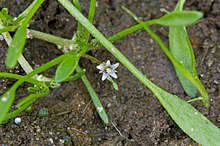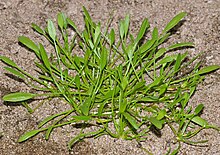Muddy
| Muddy | ||||||||||||
|---|---|---|---|---|---|---|---|---|---|---|---|---|

Muddy ( Limosella aquatica ) |
||||||||||||
| Systematics | ||||||||||||
|
||||||||||||
| Scientific name | ||||||||||||
| Limosella aquatica | ||||||||||||
| L. |
The (common) mudflat ( Limosella aquatica ), also called mudweed or mud bells , is an annual, dwarf plant species that occurs in wetlands. The genus Limosella includes eleven species worldwide, of which only the silt is represented in Central Europe . Traditionally, the slurry body is in the family of Figworts belongs (Scrophulariaceae); according to recent molecular biological investigations, however, it is classified by some authors under the plantain family (Plantaginaceae).
features
The plant is a volatile therophyte and is between two and ten centimeters high. The long-stalked, spatulate to awl, fleshy leaves grow from a basal rosette. There are angular vaginal lobes on their peduncles. Runners also arise from the leaf axils, which take root again and form small lawns. The small, pinkish-whitish flowers, three to ten millimeters in diameter, are also basal - their two to five centimeters long stems thus grow directly from the rosette - and bell-shaped in the calyx area. The short corolla tube is often yellowish, the sip is open. The flowering period extends from July to October. The fruit is a round capsule 2.5 to 4 millimeters long and 1.5 to 3 millimeters wide.
The number of chromosomes is 2n = 40.
Occurrence
The Schlammling is a pioneer colonist of open, alternately wet, humus-rich, nutrient-rich sand, mud and silt areas on the banks of water. It is a characteristic of the plant-sociological class of dwarf rush societies ("Isoëto-Nanojuncetea bufonii Br.-Bl. et Tx. Ex Westhoff et al. 1946") and in particular also the association "Cypero fusci-Limoselletum aquaticae (Oberd. 1957 ) Korneck 1960 ". In particular, zones in the water level fluctuation range of flowing water, standing alluvial water, but also in extensively managed carp ponds are populated when these are flooded or dammed in spring and early summer and periodically dry out in late summer and autumn. The seeds fall to the ground and are either drifted away or remain on the ground when the water floods again. In the next summer low water phase, they germinate - often in masses, as is typical for annual pioneer growth.
The species is rather rare and only very dispersed - but it is also easily overlooked. The focus is on large river valleys, in Germany especially the middle Elbe and the Rhine . Due to the construction of natural sandbanks and river regulations, which require a steady flow of water every season, this plant, which is already very competitive, has declined in its population. The species is not endangered in Central Europe, but is included in red lists in individual German federal states, for example .
literature
- Eckhard Garve: Atlas of the endangered fern and flowering plants in Lower Saxony and Bremen. - Nature conservation landscape conservation Lower Saxony 30, 1994, ISBN 3-922321-68-2
- Henning Haeupler , Thomas Muer: picture atlas of the fern and flowering plants of Germany (= the fern and flowering plants of Germany. Volume 2). Published by the Federal Agency for Nature Conservation. Ulmer, Stuttgart 2000, ISBN 3-8001-3364-4 .
- Richard Pott: The plant communities in Germany . UTB, Ulmer, Stuttgart 1995 (2nd edition), ISBN 978-3825280673
- Elfrune Wendelberger: Plants of the wetlands. BLV-Intensivführer, Munich 1986, ISBN 3-405-12967-2
Individual evidence
- ^ Erich Oberdorfer : Plant-sociological excursion flora for Germany and neighboring areas . With the collaboration of Angelika Schwabe and Theo Müller. 8th, heavily revised and expanded edition. Eugen Ulmer, Stuttgart (Hohenheim) 2001, ISBN 3-8001-3131-5 , pp. 834 .
Web links
- Muddy. In: FloraWeb.de.
- Muddy . In: BiolFlor, the database of biological-ecological characteristics of the flora of Germany.
- Limosella aquatica L. In: Info Flora , the national data and information center for Swiss flora . Retrieved March 6, 2016.
- Map for worldwide distribution at linnaeus.nrm.se
- Thomas Meyer: Data sheet with identification key and photos at Flora-de: Flora von Deutschland (old name of the website: Flowers in Swabia )



